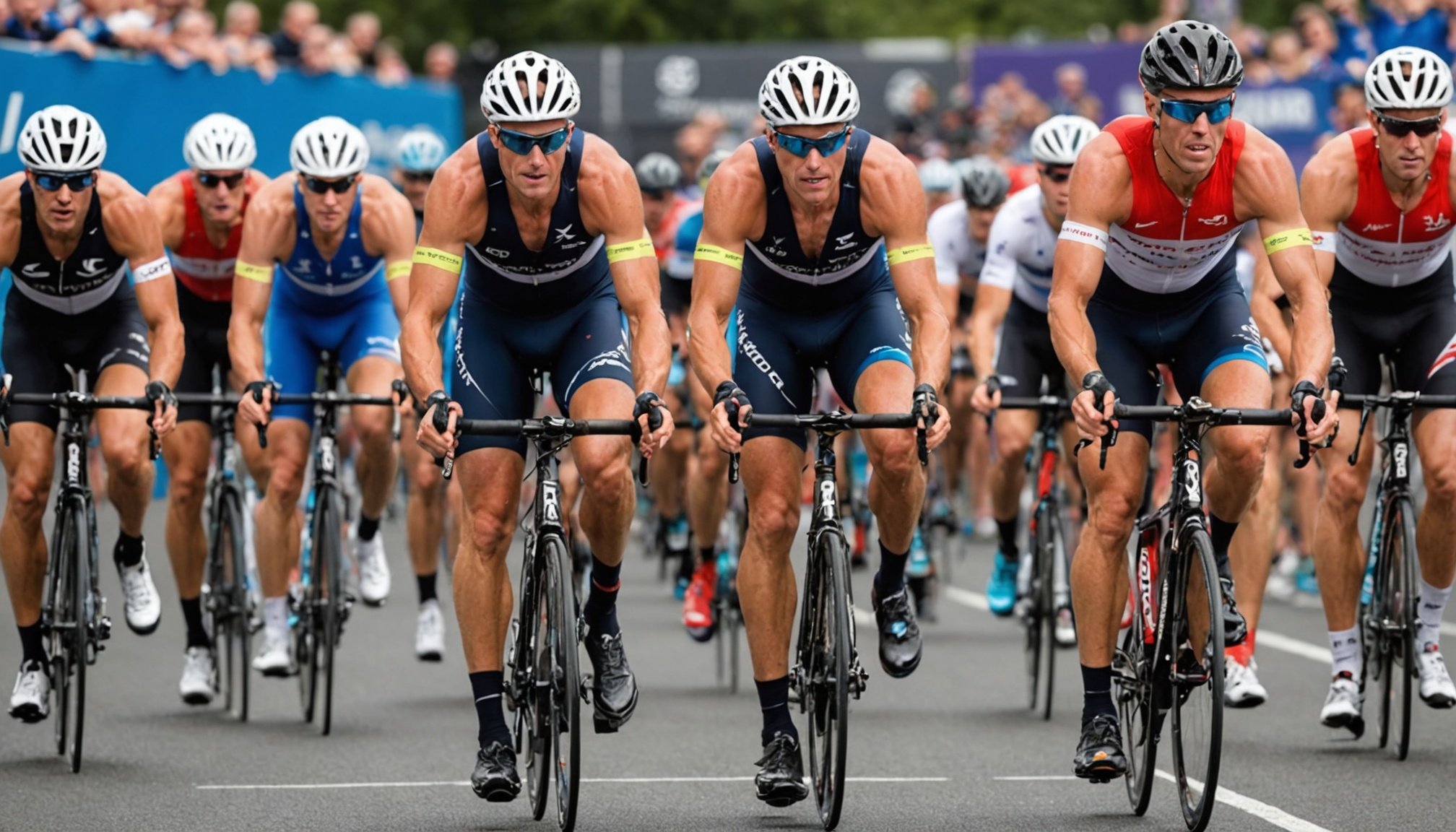Understanding Triathlon Training Essentials
Mastering triathlon training necessitates a profound understanding of its three core disciplines: swimming, cycling, and running. Each discipline presents unique requirements, demanding targeted training to optimize athlete performance.
A structured training plan is crucial in achieving peak performance. Whether you’re a novice or a seasoned athlete, a comprehensive triathlon training guide tailors your workouts to balance intensity and rest. This approach mitigates overtraining risks, which can impede progress.
Also read : Enhancing defensive strategies: utilizing game film insights for uk volleyball teams”
In the UK, triathletes often face specific hurdles. Weather conditions, particularly unpredictable rain and cold, pose a significant challenge, affecting outdoor training routines. Furthermore, the limited availability of training facilities—such as indoor pools or cycling tracks—can hinder consistent practice.
A UK triathlon strategy aids in navigating these obstacles by providing alternative solutions. For instance, incorporating cross-training indoors on a stationary bike during unfavorable weather keeps cyclists on track. Swimmers may focus on technique drills during restricted pool access to maintain progress.
Triathlon training guides offer diverse strategies to ensure that every triathlete can adapt to their circumstances, optimizing their routines. Establishing a community or joining local clubs could also bolster motivation, providing support, and sharing effective training techniques.
Balancing Swimming, Cycling, and Running
Achieving the perfect triathlon balance involves a delicate dance between swimming, cycling, and running. Each discipline demands focused attention and specific strategies for success, making multi-discipline training essential for triathletes. Implementing sport-specific strategies ensures that an athlete can transition smoothly between sports and optimize performance.
Effective Swimming Techniques
Mastering swimming techniques in triathlon requires more than just practice in the water. Incorporating warm-up routines is crucial to enhance efficiency and prevent injuries. Simple exercises like shoulder rotations and dynamic stretches prepare the body for intense effort. Furthermore, drills are indispensable for improving stroke and speed. Focusing on breathing, form, and kick techniques enhances overall performance and helps in making swift progress.
When it’s time to transition to open water, tailored preparation tips become vital. Unlike pool swimming, the open water environment can be unpredictable. Familiarizing oneself with common challenges such as currents and variable sighting helps to reduce anxiety. Practicing in similar conditions, understanding the use of buoyancy aids, and learning to manage swim caps effectively aids in minimizing resistance and maximizing confidence. By systematically addressing these elements, triathletes significantly increase their chance of a successful swim segment, paving the way for a triumphant race day.
Nutrition Strategies for Optimal Performance
Successfully managing your energy throughout a triathlon involves strategic planning and informed choices about nutrition. Triathlon nutrition plays a crucial role in not only boosting performance but also enhancing recovery, making it essential to understand the dietary guidelines specific to triathletes.
Essential nutrients are the backbone of any effective training regimen for triathletes. Proteins support muscle repair and growth, while carbohydrates fuel workouts and replenish energy stores. Healthy fats, such as those from avocados or nuts, provide sustained energy and aid in metabolic functions. Additionally, micronutrients like iron and calcium fortify your body’s resilience by supporting blood oxygenation and bone health.
Pre-race meals should focus on maximizing endurance. Ideally, this meal should be rich in complex carbohydrates, moderate in protein, and low in fat. For example, oatmeal with fruit can provide a balanced nutrient intake to fuel long distances.
Equally important is hydration, a key factor that athletes in the UK and elsewhere must tailor specifically due to varied climatic conditions. Adequate fluid consumption should start days before the race. On race day, it’s vital to monitor fluid intake to balance electrolyte levels, preventing dehydration and maintaining peak performance. This holistic approach to triathlon nutrition ensures athletes are primed and ready to face the challenges of the race.
Recovery Techniques to Enhance Training
Proper recovery methods in triathlon training are pivotal for not only improving performance but also for promoting injury prevention. By focusing on rest and nutrition, athletes can significantly enhance their training outcomes.
The Importance of Active Recovery
Active recovery plays a critical role in managing the toll that intense training sessions can take on the body. Engaging in activities like light jogging or cycling helps maintain blood circulation, facilitating the removal of metabolic waste accumulated during workouts.
Implementing yoga and stretching routines offers flexibility and stress reduction, which are invaluable for muscle recovery methods. These practices also increase oxygen flow to muscles, accelerating repair and strengthening of tissue. Ultimately, these activities contribute to enhanced athletic performance over time.
Scheduling rest days effectively is integral to injury prevention and optimal training adaptation. Designating specific days for rest allows muscles to recover fully, thereby preventing overtraining and burnout. Paying attention to the body’s signals and noticing fatigue or discomfort can guide the strategic placement of rest days to ensure continual progress.
Managing Injuries and Preventative Care
Understanding common triathlon injuries, such as tendonitis or stress fractures, aids in their prevention. Implementing targeted recovery methods like foam rolling can alleviate muscle tension, reducing the chance of such injuries. Incorporating cross-training can also distribute the mechanical load across different muscle groups, enhancing overall injury prevention. Seeking professional assistance, like physiotherapy, when unusual pain arises can provide the necessary support for effective recovery and ongoing training success.
Expert Insights and Personal Anecdotes
When training for a triathlon, engaging with seasoned triathletes can provide invaluable insights. From firsthand interviews, many experienced athletes recommend focusing on consistency rather than intensity. This helps build endurance without risking burnout.
Athlete experiences often highlight the importance of adapting to personal challenges. For instance, one veteran triathlete shared their struggle with injuries, detailing how they learned to listen to their body and adjust training routines accordingly. They suggest adopting a flexible mindset to overcome any unexpected hurdles that might come your way.
Setting realistic goals is essential, and experts consistently advise breaking down larger objectives into manageable milestones. By doing so, athletes can maintain motivation and track progress effectively. This approach not only enhances confidence but also ensures a sustainable training journey.
For those feeling overwhelmed, expert tips on maintaining motivation can make a substantial difference. Many recommend finding a training buddy or coach to provide support and accountability. Others suggest periodically revisiting the initial reasons for embarking on the triathlon journey to refocus energy and commitment.
Ultimately, the road to triathlon success involves patience, perseverance, and smart strategies garnered from collective wisdom. Embracing these expert insights not only optimizes performance but also makes the training process more enjoyable and rewarding.
Preparing for Race Day
Before participating in a triathlon, race day preparation is crucial. Proper planning leads to a smooth and efficient experience. Key considerations include organizing gear and logistics, essential for a seamless event day. It is vital to ensure equipment, such as shoes, cycling gear, and swimming attire, is ready and accessible. Preparing these items in advance prevents last-minute stress and overlooked necessities.
Triathlon strategy plays a significant role in performance. Developing a strategy involves understanding strengths and areas needing improvement. Crafting a plan for pacing can aid in maintaining endurance across different stages of the race. Moreover, focusing on transitions between events can save valuable time.
While physical readiness is essential, mental readiness cannot be underestimated. Mental preparation is integral to handling race day challenges. Techniques such as visualization and positive self-talk can enhance focus and performance. Anticipating potential obstacles can help mentally prepare for unexpected events, ensuring a calm approach when they occur.
In summary, thorough preparation involves aligning gear logistics with a well-thought-out strategy, coupled with mental techniques that foster focus and resilience. Ensuring these elements are in place can lead to a more fulfilling and successful triathlon experience.










